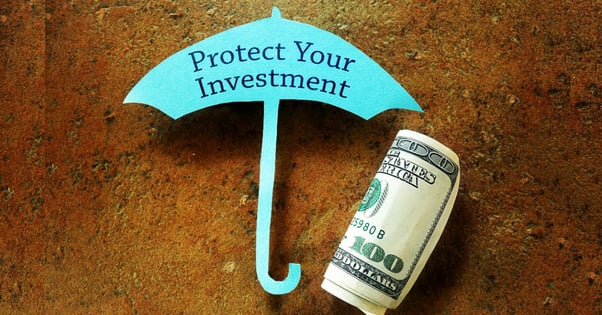How are you protecting your investments during this crisis? Were you one of those investors who changed their portfolio in response to the economic slowdown or did you do nothing at all?
According to the Schroders' Global Investor Study 2020, 78% of participants made changes to their portfolios when the market hit high volatility between February and March 2020. Around 19% did not make any moves, while 3% were unaware that the market was in turmoil.
The same survey also revealed that investors who did change their investment portfolios ranked their investment knowledge as advanced or expert. They would know what to do given the circumstances, right?
Regardless of your skill and knowledge in investing, it's recommended to protect your investment portfolio from a range of risks and not just from a market downturn.
As investor and mutual fund manager Peter Lynch said, “You get recessions, you have stock market declines. If you don’t understand that’s going to happen, then you’re not ready, you won’t do well in the markets.”
How to keep your investments secure
The coronavirus-induced recession was a wake-up call for many investors. It was a hard lesson to learn, especially when the pandemic suddenly made you realise that your portfolio had some high-risk investments. You had more stocks than bonds that would have performed better in a bear market. Or, your portfolio is not diverse enough.
If there's one thing to learn from the current crisis, it’s that you must put safety measures in place to ensure that your portfolio can ride out the next slow economy or market downturn.
1. Margin of safety
This is when you make an investment with minimal downside risk. Think of this as a built-in cushion that will help ensure your portfolio can take a hit without suffering massive negative effects.
For example, you only buy securities whose market price is below the intrinsic value. In the event that the price moves against you, you won't suffer a major loss.
How do you leverage the margin of safety?
You first need to calculate a stock's intrinsic value and only trade when the price is below it. Many undervalued companies have the potential for growth. If you have good approximations of the growth rates, you can use the margin of safety to your advantage.
The size of the margin of safety is usually based on the kind of investing you do.
Deep value investing is when you buy stocks from businesses that are seriously undervalued. This requires digging through tons of information to find valuable details that others don’t see. You can also take the Growth at a Reasonable Price investing approach where you buy stocks from companies with positive growth rates at below intrinsic fair value.
Now, mix margin of safety with diversification and you can protect your portfolio. If you buy 20 undervalued stocks, for example, and two of those work against you, 18 other investments will still work out.
2. Fund safety offered by your broker of choice
Before you open a brokerage account, you must perform your due diligence. Does a broker have security measures in place to protect your funds from risks outside of the market? These include theft, fraud, and other misconduct perpetrated by a brokerage's employees.
Different brokers secure funds in different ways.
Troubled financial firms that are members of Securities Investor Protection Corp (SIPC), for example, provide a layer of protection over clients' investments in stocks and bonds. Cash and securities are covered up to $500,000 by the SIPC. If a firm has supplemental insurance, other client assets are kept safe in the event of a financial failure.
Other brokers protect investments via anti-money laundering measures, fund segregation, and advanced security technology.
At Fullerton Markets, Forex traders' funds are protected by the triple-level protection plan, Fullerton Shield, which is also part of the Fullerton Edge.
- Segregated bank accounts ensure that client funds are kept separate from corporate funds so they're never used for operating expenses.
- Independent Custodian Protection with Fullerton Custodian so that any misappropriation or mishandling is avoided at all cost.
- Professional Indemnity and Crime Insurance to cover either internal or external wrongful acts and crimes that may be committed by the custodians.
If your broker of choice has the same layers of fund security, you can sleep well knowing that your capital is safe even when the company goes bust.
Find out more about What the Best Brokers Offer to Ensure Your Fund's Safety
3. Safety in diversification

If you want your investment portfolio to survive an economic downturn, you need to diversify strategically. That is, you must have a good allocation of stock, bonds, and other assets that will allow you to reach your financial goals while minimising risks.
Here's how you could have Cashed in During the Coronavirus Crisis
Think of it this way, if you invest all your money on pork, your portfolio will take a dive when swine flu hits. If there's a good mix of chicken and beef, however, you might get hit but not plunge entirely.
How do you diversify to reduce unsystematic risk?
- Invest in more than one asset class. Bonds are known to perform well in a recession, making it a good investment during a bear market. Certain stocks can ride out a market downturn as well. These include commodities, dividend-paying stocks, and real estate.
- Invest in different assets that can do different things for you.
- For growth and income, invest in stocks and bonds, respectively. Start with a 70/30 baseline and adjust as your risk tolerance changes.
- To hedge against inflation and as a cushion for when stock values drop, invest in real estate.
- To maintain buying power and further boost growth, invest internationally. Put your money in government funds/aids or Foreign Direct Investments.
- For a secure and stable portfolio, add cash into the mix.
- Invest in non-correlating assets. This way, when one asset depreciates, the other appreciates, helping smooth out your portfolio's volatility. To balance the equities in your investment portfolio, for example, add bonds and currencies.
The idea of diversification is to not put all your eggs in one basket, as the overused cliché goes. Your basket must not contain the same type of eggs too. If you invest in stocks, for example, invest in different industries for better protection and risk management.
4. Investment rebalancing
Financial advisers recommend that investors fine-tune their portfolio once a year or set intervals to identify where they can trim or reinvest.
But you don't need to follow the schedule if your portfolio's value shifts 5% or more, or when the goal of selling high and buying low is no longer met.
Rebalancing will also help you identify how your risk capacity and risk tolerance have changed and how you can reconcile the two. You might have started out a conservative investor but have since grown to be a risk-taker.
Your portfolio should match this change.
How do you rebalance your investments?
- Review your asset allocations and determine if they still match your ideal goal and risk appetite. For example, if you tend to panic in a market downturn, stick with a conservative asset allocation.
- Compare your ideal asset allocation with your portfolio’s current allocation. Does the current match or is close to the target?
- Buy and sell shares if needed to balance your portfolio. Your stock/bond allocation, for example, can go from 50/50 to 80/20 if you aim for aggressive growth.
5. Set investing rules to follow without fail

“Rule No. 1: Never lose money. Rule No. 2: Never forget rule No.1”
– Warren Buffett
Without rules in place, your investment decisions will be all over the place. Buffett's rule is simple and straightforward. But because emotions have a way of messing with your rational side, you need to have other rules in place.
Never react to risk or market volatility without thought.
You know your investments are exposed to risks and that no one is in control of the market. So, avoid reacting without thinking about the consequences. If you didn't sell low when the recession hit, you might have profited from the recovery. If only you stood your ground and rode out the downturn.
Never sell in a panic.
A drastic drop in your portfolio's value is a cause for concern but not a good reason to sell when the prices are low. The market is cyclical, which means the downward trend now will shift eventually. Stock values are bound to go down at some point but they will rise given time. Moreover, downturns are temporary.
Never mix emotions with investing.
Avoid doing this, and you won’t need to panic or react negatively to market conditions. You can maintain focus and make better decisions when you leave your emotions at the door.
Most importantly, never invest all your money in one asset class or industry. Diversify your asset allocation and diversify within a category.
Watch Mario Singh explain the 3 Rules of Successful Trading & Investing in this video.
Secure investments equal peace of mind
When you know that your portfolio is well-protected from market movements, whether calm or volatile, you can afford to rest easy. The market may never be without risk and volatility but if you have a better handle on them, your investment efforts will pay off.
So implement these portfolio protection strategies to achieve investing success.
Ready to build and grow your wealth? Diversify your investment portfolio and trade currencies in the world's largest financial market. No better place to start than right here with us! Begin trading with Fullerton Markets today by opening an account:
You might be interested in: 5 Things You Won't Regret Investing In














